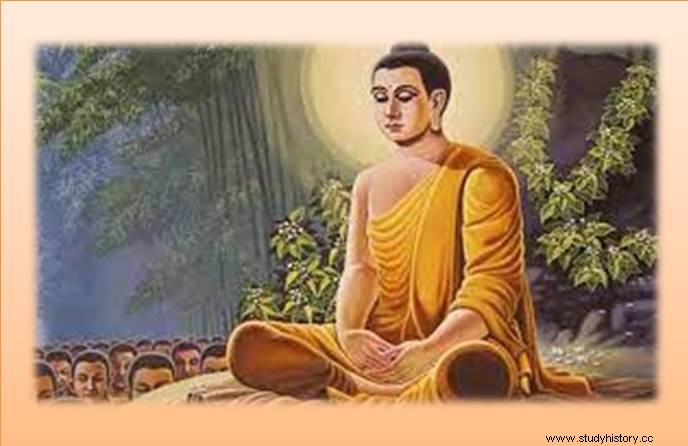
Ashoka's reign in 273 BC to 232 BC. Although he was the ruler who believed in all Indian religions, but he was the first Mauryan emperor who worked on behalf of the government for the propagation of Buddhism.
In AD 1909, the remains of a circular Buddhist chaitya (Buddhist temple) of 27 feet in diameter were found in the Bijak hill in Bairath. This chaitya is believed to have been built in the early days of Emperor Ashoka's reign. In this, instead of stones, wooden octagonal pillars and bricks were used. There were probably 26 wooden pillars at this place which were found in burnt condition. The Sabha Mandap was built by these pillars.
In the middle of each pillar were walls of bricks. The roof of the temple was also covered with wood and Kelu. The entrance of the temple was towards the east. The form of the chaitya was such that the chaityas were made by cutting the caves. It was surrounded by two circles and both circles were separated by circumambulatory path. Its similarity is made with the Chaitya cave of the Tulja Leena group of Junnar in the 1st century AD. The only difference was that the Chaitya of Bairath used wood and bricks, whereas the Chaityas of Tulja Leena were constructed by the addition of circular rows of 12 pillars cut out of stone caves.
Possibly on the imitation of Bairath's Chaitya, later other Chaityas of West and East India were formed. From the heap of ashes found here, it is estimated that this chaitya was destroyed in the fire. Dayaram Sahni has believed that it was destroyed by burning by the Hun invaders.
Bone Relics of Lord Buddha
During the reign of King Sawai Ram Singh of Jaipur, a golden ark was also found from here, which contained the ashes of Lord Buddha. The circumambulation path was made in the middle of the double wall around where the monks of the Hinayana sect kept the ashes of Lord Buddha. As also found from this place.
Faced Bricks
One or two letters were inscribed on the bricks found from the circular chaitya. Pasham on some; Vis; Woe; Work; The words etc. have also been read. Perhaps some quotations from Buddhist texts were inscribed on the walls outside the chaitya, fragments of which were found on the bricks in the form of letters and words.
Great Buddhist Vihara
The upper platform of Bijak's hill was connected by a row of wide steps. On excavation, signs of a huge Buddhist vihara were visible. Signs of six-seven cells were also found around a square circle. Perhaps the monastery in the middle was large and was inhabited by persons living with the abbot.
Or there may have been rooms to perform other functions of the abbot's daily life. Looking at the ruins of these Buddhist monasteries, it is estimated that those viharas must have been renovated two-three or more times. The bricks of this vihara were exactly the same as those found from the circular chaitya. The bricks of these cells are added to the mud mortar. There is a layer of whiteness on both the outside and inside of them.
Buddhist carpet material obtained from Bairath
From this place, the symbols of figurative pottery, tri-ratna and swastika on the wheel have been found. A large number of clay toys have also been found from here, in which there are figures of all kinds of birds. These figures are exactly the same as those of the artifacts found from Bharhut. Connected covers and pottery of different types have also been found. Northern black polished and brown or gray earthenware are found from Buddhist sites. Similar utensils are also found from this place. The presence of these utensils also confirms that this is a Buddhist place.
Lack of Buddha statue
No figure or statue of Lord Buddha has been found from here, from which it is inferred that it was a Chaitya of the Hinayana sect who did not worship Buddha as a god and did not make statues of Buddha. In the centuries after Christ, the Hinayana sect also started making idols of Lord Buddha. Many such Buddhist caves have been found from Jhalawar district of Rajasthan, which despite being associated with Hinayana, contain many Buddha statues.
Lion shaped pillar
About one hundred pieces of two smooth polished and unpolished pillars of Ashoka were found from this place. These pillars were of Chunar stone and were similar to Ashoka Pillar Khand. Looking at them, it is inferred that their upper part was tied with a long and strong copper wire. The upper part is estimated to have the shape of a lion. Many fragments of this lion have also been found from here. Rai Bahadur Dayaram Sahni had seen two pillars containing such lions at Rampurwa place in Champaran district which was made part of Rajpath.
With the receipt of two Ashoka pillars at Bairath, the total number of such pillars increased to 16. Earlier it was believed that the number of such pillars is only 14. Henry Cousins had seen one such Ashoka carpet lion head lying near the statue of Kankali Mata of Nagri (District Chittorgarh).
receipt of Ashoka carpet coins
A small earthen pot containing 36 silver coins was found in the thickness of the eastern wall of the Buddhist vihara. Of these coins, 8 coins were punchmark and 28 coins were of Greek style. All these coins are approximate during the Ashoka period.
